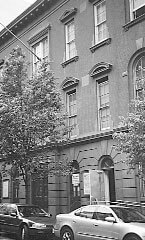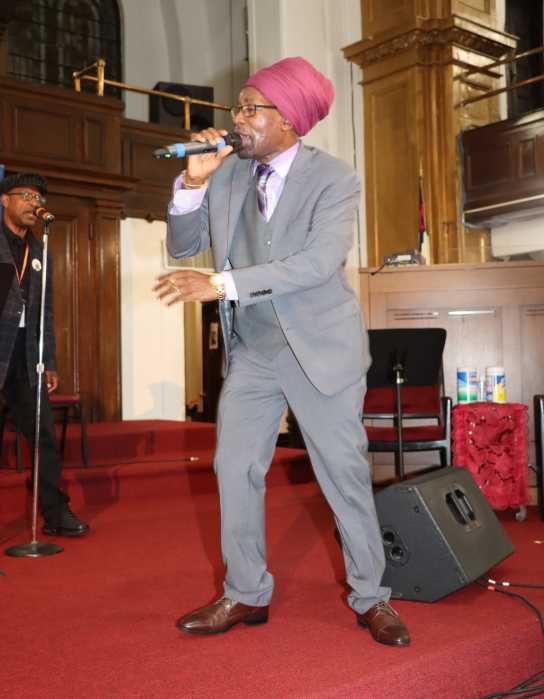Cutbacks response to public, private support outpaced by expenses
Faced with a slump in government and private funding, the Lesbian, Gay, Bisexual and Transgender (LGBT) Community Center has cut its staff by 15 percent. The Center, a lynchpin in New York’s queer community for two decades, also plans to sell or lease the smaller of its two buildings, which it purchased just two years ago.
Through a combination of layoffs and attrition, the Center eliminated nine full-time positions last month, according to executive director Richard Burns. The positions were spread among departments, including youth services, development, administration, and the computer lab.
In addition, the Center is showing its four-story brownstone, located at 221 W. 13th Street, across the street from its main building, to realtors in hopes of leasing it to other non-profit groups or selling it outright. The move is expected to save the center $13,000 a month in mortgage payments.
The Center’s $5.8-million budget is on par with last year, but costs like utilities and insurance are up, forcing the changes.
“Like both non-profits and for-profits, we’ve all been knocked and battered by the current economy,” Burns said. “We limited [the impact] for as long as possible, just by shaving expenses, but ultimately, it became necessary in order to ensure that we have a stable, balanced budget over the long-term, to cut some serious expenses.”
Virtually every funding stream took a hit, beginning with private donations. After eight years supporting LGBT centers in Boston and New York, the Pallotta Team Works Northeast AIDS Ride collapsed last year. The Center organized its own fundraising ride from the Chesapeake Bay to New York last month to bridge the gap, and the 47 riders netted the Center $140,000. That was more per cyclist than the previous AIDS ride, but still $160,000 less overall.
The Center also has around 7,500 active donors, but they are giving less on average because of the sluggish economy, Burns said.
The Center took another blow from New York State. It is among 50 organizations across the state that receive money through the Lesbian and Gay Health and Human Services Network, a program funded by the state. This year’s $1.7 million appropriation to the network matched that of 2001, yet dipped 50 percent from 2002. Programs funded through the Network focus on non-HIV related services like family counseling, education, and preventive health care.
A delay in the actual disbursement of those state funds—widely seen as a byproduct of friction between Governor Pataki and the legislature—has also hurt some organizations, according to Joe Tarver, a spokesperson for the Empire State Pride Agenda Foundation.
“Network members pretty much know that [the money] is going to come, but it comes at different times, and it is later than usual,” Tarver said.
The largest single hit for the Center was on the federal level, where a $300,000 contract through the Department of Health and Human Services (HHS) expired this fall. The contract funded a program to prevent abuse of crystal methamphetamine, a drug strongly linked to risky sex and HIV transmission among gay men.
The last four federal contracts that the Center has applied for have been rejected.
The Center is hardly alone in feeling the budget blues, especially when it comes to federal money. According to Donald Hitchcock, of the Washington-based National Coalition for LGBT Health, HHS and the Centers for Disease Prevention and Control are closely scrutinizing grant applications that explicitly target the LGBT community. In what is proving to be a Catch-22 situation, studies to determine LGBT health needs are not being funded, which in turn, gives the Bush administration reason to deny applications for services since no needs have been proven.
“The review panels that approve the grants are becoming much more right wing,” Hitchcock said. “They are being filled with people who don’t believe in condoms, and think abstinence is the solution.”
Even organizations that have limited exposure to the roller coaster of government funding are trimming.
The Callen-Lorde Community Health Center, which provides direct medical services, hasn’t seen a drop in contracts, but expects a cut to its $140,000 discretionary funding from the state. As a result, three staffers were laid off in June, managerial salaries were cut, and Callen-Lorde is pursing insurers to pick up the tab for more services.
“It has been very difficult to plan on budget monies from the state,” said Jay Laudato, the agency’s executive director. “The cut was difficult, but it did not require us to lessen any of the services we provide to our patients.”
The slump at the Center is far from a crisis, Burns insisted. The Center still employs a staff of 48, plus 17 part-timers and 15 social worker interns.
But there’s no question the public will feel the consequences. The sale of the brownstone will eliminate eight meeting rooms, making it more difficult for organizations to rent space during peak times. The Center’s main administrative office now closes two hours earlier, at 9 p.m., even with volunteers taking on more duties.
“The picture is not one of gloom and doom. We have a balanced budget that is secure and solid, but it took these cuts to make that happen,” Burns said.
He is stepping up appeals, turning out more grant applications, and may raise room rental fees.
“We are taking steps to raise money, but really, membership is key. We need members of our community to step forward.”
We also publish:

































